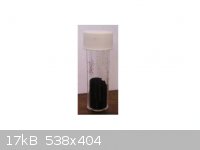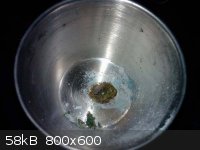12332123
Harmless

Posts: 38
Registered: 14-11-2009
Member Is Offline
Mood: No Mood
|
|
Boron
As a way-point on my ongoing path towards experimenting with borane reductions of amides, I have prepared a small sample of boron of acceptable
purity.
Pre-prepared boric anhydride, produced from the acid by drying at ~300 degrees, was added in chunks to a nickel crucible suspended over a gas flame.
An unexpectedly large volume of foam was observed, indicating incomplete dehydration. Stirring was needed to prevent foam-over. When the melt reached
dull red heat and no more steam was evolved it was declared anhydrous and the crucible was weighed, giving a mass of 11.15 grams of B2O3.
A stoichiometric amount of magnesium turnings and a small pinch of sulfur were added and the crucible was covered. After 90 mins of strong heating,
the reactants had formed a fused mass.
The crucible was added to ~200ml of H2O and small amounts of conc H2SO4 were pipetted in to help disaggregate the products. When all the products had
been liberated from the crucible it was removed and strong stirring was applied. More H2SO4 was added until effervescence ceased and the resultant
suspension was gravity filtered (It is very much recommended to do this outside or in a hood to avoid the repulsively meaty stench of boranes)
The filter cake was washed with a large volume of dilute H2SO4, then distilled water, MeOH, and DCM in turn. This air-dried quickly giving 340mg
(~10%) of beautiful (in the eyes of this beholder at least), fine black boron powder.
Next up, magnesium diboride...
[Edited on 25-3-2011 by 12332123]

|
|
|
MrHomeScientist
International Hazard
    
Posts: 1806
Registered: 24-10-2010
Location: Flerovium
Member Is Offline
Mood: No Mood
|
|
Nice! I made boron using a similar process, and you can see the video here:
http://www.youtube.com/watch?v=0QBCyOrjR2o
Instead of heating it in a crucible with Mg, I essentially made a thermite out of it. It had trouble burning all the way through though, so I had to
light it a couple times before everything was reacted. My B2O3 was hard as hell to crush into a powder for that.
Your product looks great! Mine was contaminated by bits of clay and sand as a result of the way I did it, so I'll be trying this again in the future
to see if I can clean it up a bit.
|
|
|
m1tanker78
National Hazard
   
Posts: 685
Registered: 5-1-2011
Member Is Offline
Mood: No Mood
|
|
Are you sure that's elemental boron? The reason I ask is because a while back, I did several experiments that were geared toward reduction of borates.
Although I succeeded in doing so, removing it from the crucible required an act of congress. Even the highest MP steel alloy I could get my hands on
at the time melted at or below the MP of boron. I ruined several steel crucibles as well as a couple of ceramic ones. Even then, the boron was
contaminated with carbon, 'glass', silicon, and who knows what else.
I don't easily give up on something once my mind is set but I flat-out abandoned this one!
What was your source of heat and what did you use for a crucible?
Edit: Sorry, I misread your post. I thought you said you had elemental boron powder in the vial.
Tom
[Edited on 3-25-2011 by m1tanker78]
|
|
|
12332123
Harmless

Posts: 38
Registered: 14-11-2009
Member Is Offline
Mood: No Mood
|
|
@ m1tanker78
I didn't say it, but I do believe that is pure boron. I think you misunderstand the process - no melting of the boron is involved. All borides and
oxides and most of the magnesium should have been removed by the leeching, so, though I don't have much proof, I do think it is pretty pure. For a
similar reaction giving 93% pure boron see:
http://www.inoe.ro/JOAM/pdf7_1/Yavas.pdf
|
|
|
MrHomeScientist
International Hazard
    
Posts: 1806
Registered: 24-10-2010
Location: Flerovium
Member Is Offline
Mood: No Mood
|
|
The product should be quite pure. The water and acid washing steps get rid of all other products of this process. Take a look at the description in my
video - I list out all the reactions for every reactant and product from each step. Everything that isn't boron gets reacted into something soluble or
escapes as a gas.
|
|
|
m1tanker78
National Hazard
   
Posts: 685
Registered: 5-1-2011
Member Is Offline
Mood: No Mood
|
|
Quote: Originally posted by 12332123  | @ m1tanker78
I didn't say it, but I do believe that is pure boron. I think you misunderstand the process - no melting of the boron is involved. All borides and
oxides and most of the magnesium should have been removed by the leeching, so, though I don't have much proof, I do think it is pretty pure. For a
similar reaction giving 93% pure boron see:
http://www.inoe.ro/JOAM/pdf7_1/Yavas.pdf |
Now that I'm fully awake.... 
Yes, I misunderstood the process. Apples and oranges.
@Mr HS: Nice work on the vid - it helped to clear things up for me.
Tom
|
|
|
blogfast25
International Hazard
    
Posts: 10562
Registered: 3-2-2008
Location: Neverland
Member Is Offline
Mood: No Mood
|
|
Nice video, MrHomeScientist...
|
|
|
UnintentionalChaos
International Hazard
    
Posts: 1454
Registered: 9-12-2006
Location: Mars
Member Is Offline
Mood: Nucleophilic
|
|
You may be interested in looking at Brauer (Vol 1, pg 770). It has quoted conditions for making amorphous boron (80-90% pure) by a nearly analogous
reaction to yours involving B2O3, Mg, and sulfur (but run as a thermite). "After the mixture has cooled, it is extracted in water and then in dilute
HCl for a week. The residue is treated several times by heating with HF and HCl, washed with water and dried in vacuum at 100C." Brauer then gives a
procedure for ~98.9% B made by high temperature reduction of BBr3 with hydrogen in quartz apparatus.
Department of Redundancy Department - Now with paperwork!
'In organic synthesis, we call decomposition products "crap", however this is not a IUPAC approved nomenclature.' -Nicodem
|
|
|
m1tanker78
National Hazard
   
Posts: 685
Registered: 5-1-2011
Member Is Offline
Mood: No Mood
|
|
What is the function of sulphur in this reaction?
I wonder about reacting boric acid with elemental sodium or potassium. If I remember correctly, this is how Lussac and Thenard as well as Davy
isolated it back in the day. This is essentially what I did a couple of years back only I did it in situ and at very high temperatures. Now that I
have a little Na to spare, I might give this a shot on a small scale if one of you will give me some pointers to minimize waste.
First off, at what temperature should the reaction proceed? At the moment, I assume that the Na and boric acid need only be molten.
Second, I assume it's better to use an excess of Na since NaOH is much easier to get rid of than excess boric acid (more like boron trioxide?).
Of course, this is assuming it'll work at all. I don't have any particular use for elemental boron right now so it would be done on a small scale and
on the fly.
Tom
|
|
|
m1tanker78
National Hazard
   
Posts: 685
Registered: 5-1-2011
Member Is Offline
Mood: No Mood
|
|
Ok well I went ahead and tried it anyway... 
I took about a gram of Na, cleaned off the oil and smashed it flat for more surface area.
I ran out of 'pure' boric acid so used roach powder that's tinted blue.  I used an
excess of BA just to see what would happen and to create a crust over the Na. I figured that should protect it from the air a little better.. I used an
excess of BA just to see what would happen and to create a crust over the Na. I figured that should protect it from the air a little better..
It took a little more heat than I had anticipated to drive it to completion. Nothing exploded so all was good there. After I tapped all the crust
away, what's left is a copper-brown layer. As of yet, I haven't detected any hydroxide in there so I'm assuming that all of the Na was reacted.
Your guess is as good (probably better) than mine:

Tom
|
|
|
blogfast25
International Hazard
    
Posts: 10562
Registered: 3-2-2008
Location: Neverland
Member Is Offline
Mood: No Mood
|
|
Remember that is a thermite reaction so with Al (not Mg).
The method essentially emulates the Goldschmidt reaction for silicon. In that thermite (SiO2 + Al) extra Al and sulfur are added to get extra heat
because 2 Al + 3 S === > Al2S3 is so exothermic. The extra Al and sulphur are also called a 'heat booster'. Without it the reaction is very
sluggish and cool.
Drawback is that Al2S3 hydrolyses very keenly, so lots of H2S is liberated. CAUTION: HIGHLY POISONOUS (more poisonous than HCN!)
|
|
|
m1tanker78
National Hazard
   
Posts: 685
Registered: 5-1-2011
Member Is Offline
Mood: No Mood
|
|
Quote: Originally posted by blogfast25  |
Remember that is a thermite reaction so with Al (not Mg).
The method essentially emulates the Goldschmidt reaction for silicon. In that thermite (SiO2 + Al) extra Al and sulfur are added to get extra heat
because 2 Al + 3 S === > Al2S3 is so exothermic. The extra Al and sulphur are also called a 'heat booster'. Without it the reaction is very
sluggish and cool.
Drawback is that Al2S3 hydrolyses very keenly, so lots of H2S is liberated. CAUTION: HIGHLY POISONOUS (more poisonous than HCN!)
|
Got it, thanks for clearing that up.
Tom
|
|
|
White Yeti
National Hazard
   
Posts: 816
Registered: 20-7-2011
Location: Asperger's spectrum
Member Is Offline
Mood: delocalized
|
|
I would be interested to know how you will make magnesium diboride. It's one of the easiest superconductors to make.
Good luck!
|
|
|